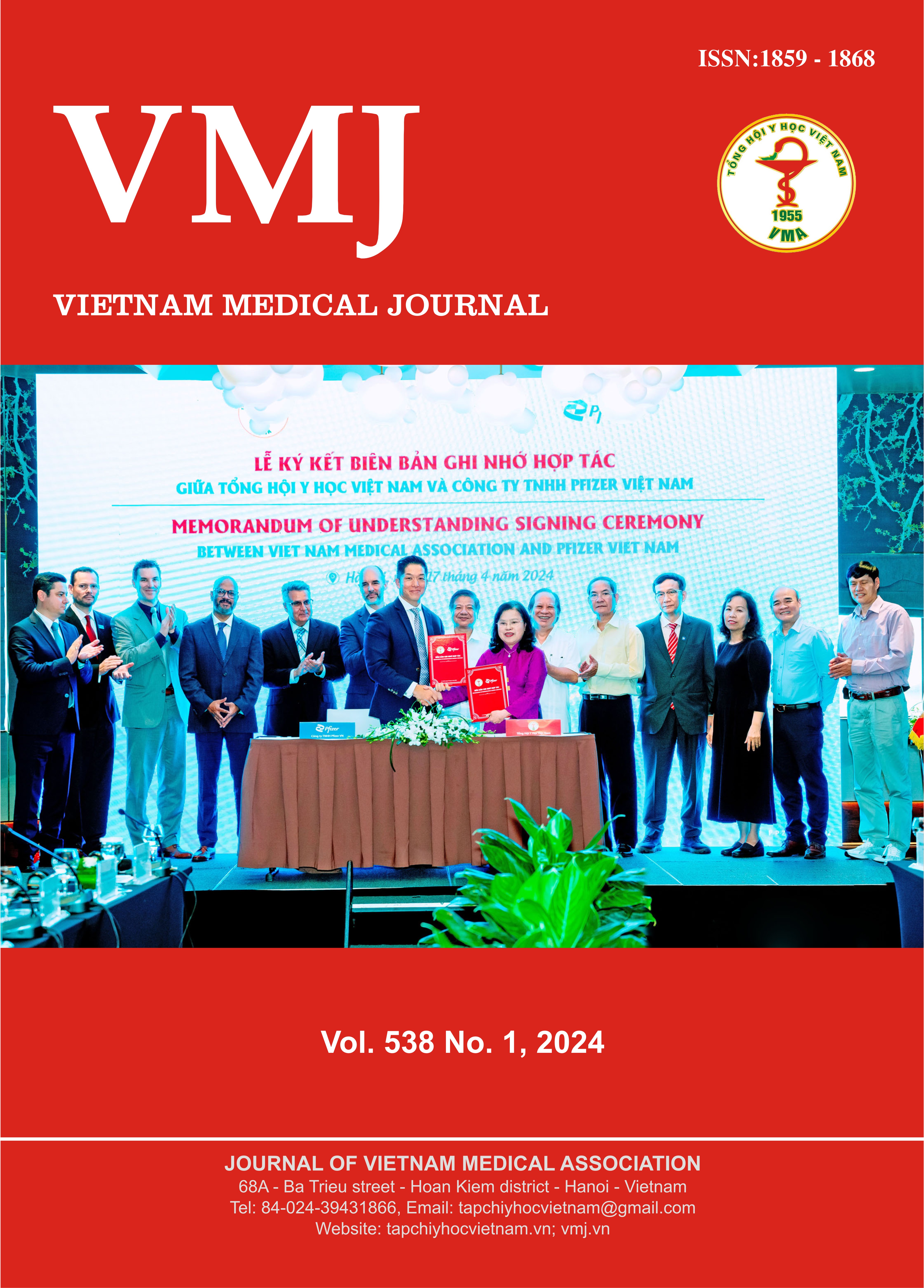CLINICAL CHARACTERISTICS OF AURICULAR KELOIDS TREATED SURGICALLY AT 108 MILITARY CENTRAL HOSPITAL
Main Article Content
Abstract
Purpose: to describe the clinical characteristics of surgically treated auricular keloids. Subjects and methods: Cross-sectional descriptive study on 45 patients with auricular keloid surgery at 108 Military Central Hospital during the period from June 2020 to June 2023. Study subjects had their past medical history taken, clinical examination, and lesion size measured to record research indicators. Results: The study subjects had an average age of 20.7 ± 4.4 years old, all patients were female, accounting for 100%. The main cause of keloids is ear piercing, accounting for 97.7%. Surgical auricular keloids have an average size of 4 ± 3.5 cm2, the main location of keloids is in the helix accounting 44.1% and the earlobe accounting for 41.93%, the number of keloids is from 1 to 5. Conclusion: auricular keloids are mainly found in teenagers with an average age of 20.7 years old, 100% are female patients, 97.7% are caused by piercing. The location of keloids treated by surgery is in the earlobe and helix areas account for 44.1% and 41.93%, respectively; On average, there are 1.76 keloids/person, the average auricular keloid size is 4.07±3.58 cm, mainly in groups 3 and 4 according to Michael Tirgan's classification (1).
Article Details
Keywords
keloid, auricular keloid, keloid surgery
References
2. Park TH, Seo SW, Kim JK, Chang CH. Outcomes of surgical excision with pressure therapy using magnets and identification of risk factors for recurrent keloids. Plast Reconstr Surg. 2011;128(2):431-439. doi:10.1097/PRS.0b013e31821e7006
3. Noishiki C, Hayasaka Y, Ogawa R. Sex Differences in Keloidogenesis: An Analysis of 1659 Keloid Patients in Japan. Dermatol Ther (Heidelb). 2019;9(4):747-754. doi:10.1007/s13555-019-00327-0.
4. Lu W sheng, Zheng X dong, Yao X hua, Zhang L fang. Clinical and epidemiological analysis of keloids in Chinese patients. Arch Dermatol Res. 2015;307(2):109-114. doi:10.1007/s00403-014-1507-1.
5. Wolfram D, Tzankov A, Pülzl P, Piza-Katzer H. Hypertrophic scars and keloids--a review of their pathophysiology, risk factors, and therapeutic management. Dermatol Surg. 2009;35(2):171-181. doi:10.1111/j.1524-4725.2008.34406.x.
6. Bayat A, Arscott G, Ollier WER, McGrouther DA, Ferguson MWJ. Keloid disease: clinical relevance of single versus multiple site scars. Br J Plast Surg. 2005;58(1):28-37. doi:10.1016/j.bjps.2004.04.024.
7. Analysis of the surgical treatments of 63 keloids on the cartilaginous part of the auricle: effectiveness of the core excision method - PubMed. Accessed October 14, 2023. https://pubmed.ncbi.nlm.nih.gov/25719703.
8. Marneros AG, Norris JEC, Olsen BR, Reichenberger E. Clinical Genetics of Familial Keloids. Archives of Dermatology. 2001;137(11):1429-1434. doi:10.1001/archderm.137.11.1429
9. Van Wijk MP, Kummer JA, Kon M. Ear piercing techniques and their effect on cartilage, a histologic study. Journal of Plastic, Reconstructive & Aesthetic Surgery. 2008;61:S104-S109. doi:10.1016/j.bjps.2007.01.077
10. Tirgan M. Massive ear keloids: Natural history, evaluation of risk factors and recommendation for preventive measures – A retrospective case series. Published online March 21, 2017. doi:10.12688/f1000research.9504.2
11. Chen F, Kuo YR, Huang CJ, Tang JY, Chiang CH, Huang MY. Lesion Site Is the Key Prognostic Factor for Keloid Patients Receiving Surgery With Adjuvant Radiotherapy. Ann Plast Surg. 2022;89(6):626-630. doi:10.1097/SAP.0000000000003315
12. Lane JE, Waller JL, Davis LS. Relationship between age of ear piercing and keloid formation. Pediatrics. 2005;115(5):1312-1314. doi:10.1542/peds.2004-1085
13. Quality of life of patients with keloid and hypertrophic scarring - PubMed. Accessed August 21, 2022. https://pubmed.ncbi.nlm.nih.gov 16528552


